One. Power Conversion Module
The so-called power supply voltage refers to the input voltage that is converted through a voltage conversion circuit to achieve boosting or bucking functions for other modules. In the production of smart cars, the input battery voltage is 7.2V, and the required voltages for different modules are as follows: 3.3V for the minimum system board, OLED, and Eagle Eye camera; ±5V for the op-amp power supply; 6V for the servo motor; 12V for the drive circuit; and 5V for the CCD and encoder.
Voltage regulator circuits are mainly divided into several categories:
1. LM2940 to 5V:
LM2940 is a series linear regulator (only for buck). This type of circuit has a simple structure and high stability but consumes more power, is larger in size, and has lower filtering efficiency. It requires large input and output filter capacitors.
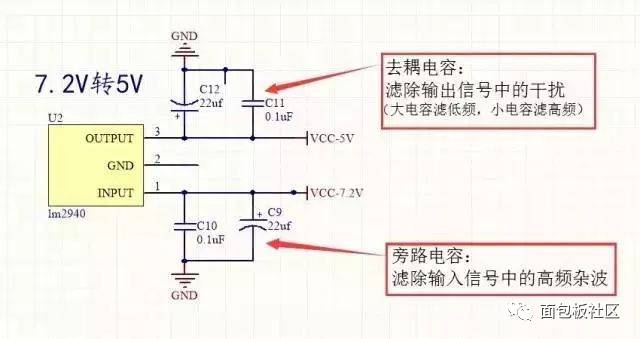 2. MC34063 to 12V:
MC34063 is a switching DC regulator chip that can be used for both boosting and bucking. This type of circuit is efficient, compact, and lightweight, with a wide voltage regulation range. However, it has a more complex structure and a higher failure rate. The working principle involves the internal switch turning on continuously, charging and discharging an inductor and capacitor to provide energy to the load. The output voltage is calculated using the formula Uo = 1.25 × (1 + R4/R3).
2. MC34063 to 12V:
MC34063 is a switching DC regulator chip that can be used for both boosting and bucking. This type of circuit is efficient, compact, and lightweight, with a wide voltage regulation range. However, it has a more complex structure and a higher failure rate. The working principle involves the internal switch turning on continuously, charging and discharging an inductor and capacitor to provide energy to the load. The output voltage is calculated using the formula Uo = 1.25 × (1 + R4/R3).
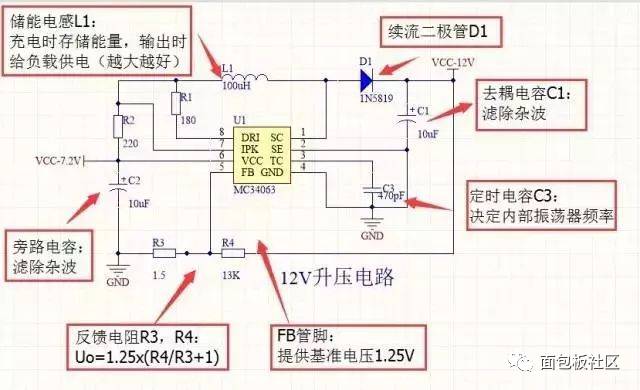 3. MIC29302 to 6V:
MIC29302 is a linear adjustable regulator similar to the 34063 circuit and can handle high current loads. Its output voltage formula is Uo = 1.242 × (1 + R1/R2). In this case, the 6V output powers the steering gear.
3. MIC29302 to 6V:
MIC29302 is a linear adjustable regulator similar to the 34063 circuit and can handle high current loads. Its output voltage formula is Uo = 1.242 × (1 + R1/R2). In this case, the 6V output powers the steering gear.
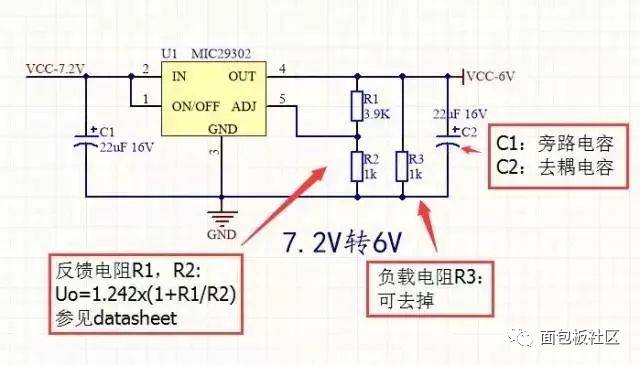 4. LM2663 to -5V:
LM2663 is a simple negative voltage converter that uses only two external capacitors to generate a negative voltage.
4. LM2663 to -5V:
LM2663 is a simple negative voltage converter that uses only two external capacitors to generate a negative voltage.
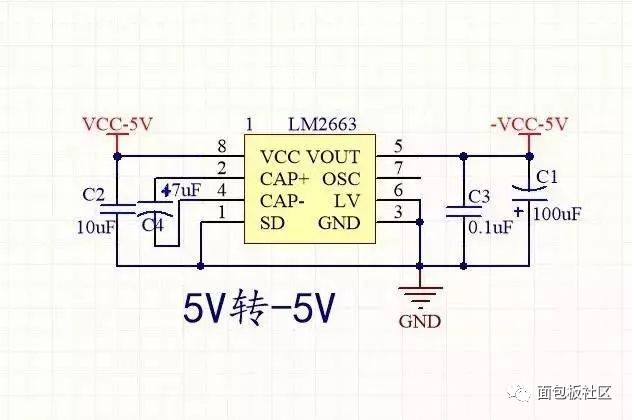 Note: Reverse connections due to manual errors should be avoided as much as possible. Adding anti-reverse protection to the circuit is recommended.
1. Using the unidirectional conductivity of a diode:
This method prevents reverse current by placing a diode in the circuit.
Note: Reverse connections due to manual errors should be avoided as much as possible. Adding anti-reverse protection to the circuit is recommended.
1. Using the unidirectional conductivity of a diode:
This method prevents reverse current by placing a diode in the circuit.
 2. MOSFET-based anti-reverse protection circuit:
An NMOS transistor is connected to the negative terminal of the power supply, and the gate is turned on at a high level. A PMOS transistor is connected to the positive terminal, and the gate is turned on at a low level. NMOS is preferred because its on-resistance is smaller.
2. MOSFET-based anti-reverse protection circuit:
An NMOS transistor is connected to the negative terminal of the power supply, and the gate is turned on at a high level. A PMOS transistor is connected to the positive terminal, and the gate is turned on at a low level. NMOS is preferred because its on-resistance is smaller.
 3. Various anti-reverse interfaces.
Two. Motor Drive Circuit
The MCU can output a DC signal, but its driving capability is limited. Therefore, the MCU usually drives a large power transistor such as a MOSFET (LR7843) to generate a large current and drive the motor. By controlling the duty cycle, the average voltage applied to the motor can be adjusted, achieving speed control.
The motor drive circuit primarily uses N-channel MOSFETs to build an H-bridge configuration. An H-bridge is a typical DC motor control circuit named for its shape resembling the letter "H." The four switches form the vertical legs of the H, while the motor acts as the horizontal bar. To make the motor run, a pair of diagonal switches must be turned on, and the direction of the current determines the motor's rotation.
3. Various anti-reverse interfaces.
Two. Motor Drive Circuit
The MCU can output a DC signal, but its driving capability is limited. Therefore, the MCU usually drives a large power transistor such as a MOSFET (LR7843) to generate a large current and drive the motor. By controlling the duty cycle, the average voltage applied to the motor can be adjusted, achieving speed control.
The motor drive circuit primarily uses N-channel MOSFETs to build an H-bridge configuration. An H-bridge is a typical DC motor control circuit named for its shape resembling the letter "H." The four switches form the vertical legs of the H, while the motor acts as the horizontal bar. To make the motor run, a pair of diagonal switches must be turned on, and the direction of the current determines the motor's rotation.
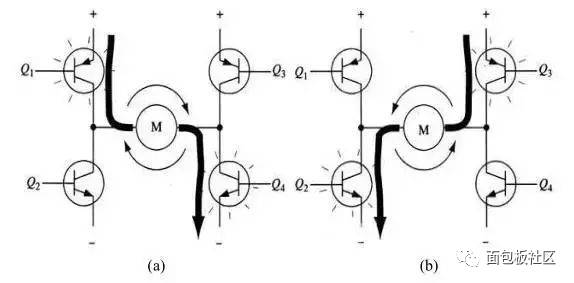 H-bridge Drive Principle
In practical applications, the switches are often controlled by a hardware circuit. The motor driver board mainly uses two types of driver chips: the full-bridge driver HIP4082 and the half-bridge driver IR2104. The half-bridge consists of two MOSFETs, while the full-bridge uses four.
The IR2104 half-bridge driver chip can drive both high-side and low-side N-channel MOSFETs, provides a large gate drive current, and includes features like hardware dead time and anti-same-arm conduction.
H-bridge Drive Principle
In practical applications, the switches are often controlled by a hardware circuit. The motor driver board mainly uses two types of driver chips: the full-bridge driver HIP4082 and the half-bridge driver IR2104. The half-bridge consists of two MOSFETs, while the full-bridge uses four.
The IR2104 half-bridge driver chip can drive both high-side and low-side N-channel MOSFETs, provides a large gate drive current, and includes features like hardware dead time and anti-same-arm conduction.
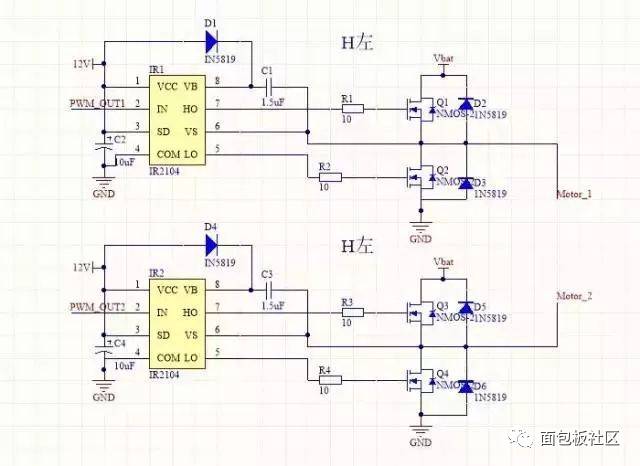 Additionally, since the driver circuit may produce a large back-EMF current, it's better to isolate the chip to protect the microcontroller. Common isolation chips include 74LVC245, 74HC244, and PS2801. These chips are often used as control buses to improve driving ability. Under certain conditions, the output matches the input, allowing one-way signal transmission, which helps drive signals from the microcontroller to the driver chip and vice versa.
Additionally, since the driver circuit may produce a large back-EMF current, it's better to isolate the chip to protect the microcontroller. Common isolation chips include 74LVC245, 74HC244, and PS2801. These chips are often used as control buses to improve driving ability. Under certain conditions, the output matches the input, allowing one-way signal transmission, which helps drive signals from the microcontroller to the driver chip and vice versa.
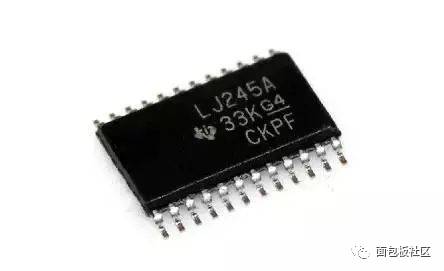
 2. MC34063 to 12V:
MC34063 is a switching DC regulator chip that can be used for both boosting and bucking. This type of circuit is efficient, compact, and lightweight, with a wide voltage regulation range. However, it has a more complex structure and a higher failure rate. The working principle involves the internal switch turning on continuously, charging and discharging an inductor and capacitor to provide energy to the load. The output voltage is calculated using the formula Uo = 1.25 × (1 + R4/R3).
2. MC34063 to 12V:
MC34063 is a switching DC regulator chip that can be used for both boosting and bucking. This type of circuit is efficient, compact, and lightweight, with a wide voltage regulation range. However, it has a more complex structure and a higher failure rate. The working principle involves the internal switch turning on continuously, charging and discharging an inductor and capacitor to provide energy to the load. The output voltage is calculated using the formula Uo = 1.25 × (1 + R4/R3).
 3. MIC29302 to 6V:
MIC29302 is a linear adjustable regulator similar to the 34063 circuit and can handle high current loads. Its output voltage formula is Uo = 1.242 × (1 + R1/R2). In this case, the 6V output powers the steering gear.
3. MIC29302 to 6V:
MIC29302 is a linear adjustable regulator similar to the 34063 circuit and can handle high current loads. Its output voltage formula is Uo = 1.242 × (1 + R1/R2). In this case, the 6V output powers the steering gear.
 4. LM2663 to -5V:
LM2663 is a simple negative voltage converter that uses only two external capacitors to generate a negative voltage.
4. LM2663 to -5V:
LM2663 is a simple negative voltage converter that uses only two external capacitors to generate a negative voltage.
 Note: Reverse connections due to manual errors should be avoided as much as possible. Adding anti-reverse protection to the circuit is recommended.
1. Using the unidirectional conductivity of a diode:
This method prevents reverse current by placing a diode in the circuit.
Note: Reverse connections due to manual errors should be avoided as much as possible. Adding anti-reverse protection to the circuit is recommended.
1. Using the unidirectional conductivity of a diode:
This method prevents reverse current by placing a diode in the circuit.
 2. MOSFET-based anti-reverse protection circuit:
An NMOS transistor is connected to the negative terminal of the power supply, and the gate is turned on at a high level. A PMOS transistor is connected to the positive terminal, and the gate is turned on at a low level. NMOS is preferred because its on-resistance is smaller.
2. MOSFET-based anti-reverse protection circuit:
An NMOS transistor is connected to the negative terminal of the power supply, and the gate is turned on at a high level. A PMOS transistor is connected to the positive terminal, and the gate is turned on at a low level. NMOS is preferred because its on-resistance is smaller.
 3. Various anti-reverse interfaces.
Two. Motor Drive Circuit
The MCU can output a DC signal, but its driving capability is limited. Therefore, the MCU usually drives a large power transistor such as a MOSFET (LR7843) to generate a large current and drive the motor. By controlling the duty cycle, the average voltage applied to the motor can be adjusted, achieving speed control.
The motor drive circuit primarily uses N-channel MOSFETs to build an H-bridge configuration. An H-bridge is a typical DC motor control circuit named for its shape resembling the letter "H." The four switches form the vertical legs of the H, while the motor acts as the horizontal bar. To make the motor run, a pair of diagonal switches must be turned on, and the direction of the current determines the motor's rotation.
3. Various anti-reverse interfaces.
Two. Motor Drive Circuit
The MCU can output a DC signal, but its driving capability is limited. Therefore, the MCU usually drives a large power transistor such as a MOSFET (LR7843) to generate a large current and drive the motor. By controlling the duty cycle, the average voltage applied to the motor can be adjusted, achieving speed control.
The motor drive circuit primarily uses N-channel MOSFETs to build an H-bridge configuration. An H-bridge is a typical DC motor control circuit named for its shape resembling the letter "H." The four switches form the vertical legs of the H, while the motor acts as the horizontal bar. To make the motor run, a pair of diagonal switches must be turned on, and the direction of the current determines the motor's rotation.
 H-bridge Drive Principle
In practical applications, the switches are often controlled by a hardware circuit. The motor driver board mainly uses two types of driver chips: the full-bridge driver HIP4082 and the half-bridge driver IR2104. The half-bridge consists of two MOSFETs, while the full-bridge uses four.
The IR2104 half-bridge driver chip can drive both high-side and low-side N-channel MOSFETs, provides a large gate drive current, and includes features like hardware dead time and anti-same-arm conduction.
H-bridge Drive Principle
In practical applications, the switches are often controlled by a hardware circuit. The motor driver board mainly uses two types of driver chips: the full-bridge driver HIP4082 and the half-bridge driver IR2104. The half-bridge consists of two MOSFETs, while the full-bridge uses four.
The IR2104 half-bridge driver chip can drive both high-side and low-side N-channel MOSFETs, provides a large gate drive current, and includes features like hardware dead time and anti-same-arm conduction.
 Additionally, since the driver circuit may produce a large back-EMF current, it's better to isolate the chip to protect the microcontroller. Common isolation chips include 74LVC245, 74HC244, and PS2801. These chips are often used as control buses to improve driving ability. Under certain conditions, the output matches the input, allowing one-way signal transmission, which helps drive signals from the microcontroller to the driver chip and vice versa.
Additionally, since the driver circuit may produce a large back-EMF current, it's better to isolate the chip to protect the microcontroller. Common isolation chips include 74LVC245, 74HC244, and PS2801. These chips are often used as control buses to improve driving ability. Under certain conditions, the output matches the input, allowing one-way signal transmission, which helps drive signals from the microcontroller to the driver chip and vice versa.

Wuxi Ark Technology Electronic Co.,Ltd. , https://www.arkledcn.com